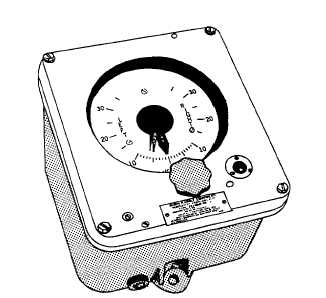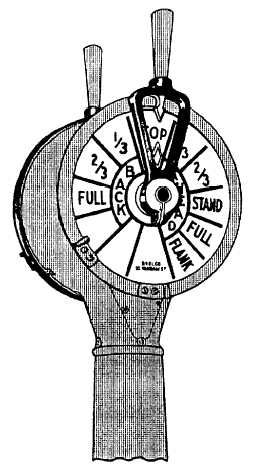| |
Figure 2-7.— Rudder angle order indicator-transmitter.
marked “ORD” is moved to the desired rudder angle.
The order is displayed in after steering on another
rudder angle order indicator-transmitter, from which the
after helmsman receives orders. A push switch next to
the rudder angle order indicator-transmitter on the
bridge operates a bell in after steering to call the
helmsman's attention to a change in rudder angle.
ENGINE ORDER TELEGRAPH
On the conning platform, an instrument called the
engine order telegraph (fig. 2-8) communicates speed
orders to the engineroom. The engine order telegraph is
circular, with duplicate dials divided into sectors for
flank, full, standard, 2/3, and 1/3 speed ahead; 1/3, 2/3,
and full speed back. A hand lever fitted with an indicator
travels over the circumference of the circular face of the
instrument. When the handle is moved to the required
speed sector, the engineroom complies with the order
immediately and notifies the bridge by operating an
answering pointer that follows into the same sector.
A ship with one engine has a telegraph with a single
handle. Two-engine ships usually have a handle on the
port side and another on the starboard side of the
telegraph, controlling the engines on the corresponding
sides, (The engine order telegraph shown in figure 2-8
is equipped with separate handles for port and starboard
engines.) Be sure you have grasped the handle for the
correct engine before you operate it. If the answering
pointer moves to the wrong sector, does not move at all,
or moves to a line between two sectors so that you are
in doubt about the speed set on the engine, repeat your
operation on the lever. If the pointer does not move to
Figure 2-8.— Engine order telegraph.
clear up the riddle, report the situation immediately to
the officer of the deck.
If a casualty occurs in the engineroom, the speed
may be changed by the engineroom without orders from
the officer of the deck. In such an event, the answering
pointer moves to the speed set in the engineroom.
Report any change in the engine order telegraph to the
officer of the deck at once. Also report to the OOD
immediately if you fail to receive an answer on the
pointer when you indicate a speed. The safety of your
own ship and others may depend on the immediate and
correct transmission of orders to the engines.
Before getting underway, the telegraph is always
tested by moving the handle to each sector, and
checking the response on the answering pointer. In the
event of casualty to the telegraph, the engineroom
receives orders over the sound-powered phones.
ENGINE REVOLUTION TELEGRAPH
On or near the engine order telegraph, you normally
will find another device, the propeller order
2-7
|


